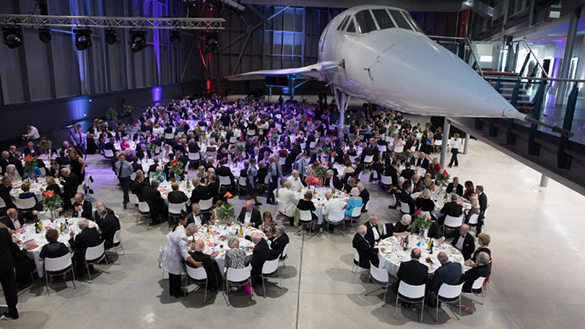Institution news
The first thing to go supersonic may have been a dinosaur’s tail. Some paleobiologists believe that long-tailed dinosaurs such as Apatosaurus could flick their tails at Mach 1 (1,225km/h) speed to generate an intimidating booming noise. We’ve been creating our own mini-sonic booms for centuries, too, through the crack of a bullwhip and the sound of gunfire.
The sound barrier first became an issue for engineers during the early 20th century – because as aircraft approach the speed of sound they start to be affected by invisible turbulence. “It would start to misbehave in a way that wasn’t visible to the pilot,” says Andy Green. “It just wasn’t working the way that it says on the tin, and it’s one of those scary monsters that will bite you very hard. You need an awful lot of very clever science to understand it.”
The difficulty of exceeding certain speeds in propeller-powered planes was one of the driving forces behind the development of jet engines. In 1944, the UK Ministry of Aviation started a top-secret project aimed at breaking the sound barrier. Working with Miles Aircraft, they created the Miles M.52, which was designed to travel at 1,000mph and reach 36,000ft in 90 seconds. In 1944, the UK and US signed an agreement to share research and data on high-speed travel, but the US reneged on the deal.
America had been working on its own secret supersonic project. In 1947, US Air Force Captain Chuck Yeager became the first pilot to officially break the sound barrier, reaching a speed of 807.2mph in the Bell X-1 rocket-powered aircraft, which was designed to resemble a machine-gun bullet – a projectile known to be stable in supersonic flight.

The allure of going supersonic is “partly psychological,” says Andy. “It’s a barrier which is completely invisible, and incredibly difficult to understand.” Despite that, breaking it now has become so routine that Andy and his colleagues have to be careful not to do it by accident when flying state-of-the-art aircraft such as the Typhoon, so that inadvertent sonic booms don’t shatter windows on the ground.
Although it can be deafening for those in the vicinity, breaking the sound barrier feels very different from inside the cockpit – Mach 1 isn’t much different from Mach 0.9. “The best analogy I can come up with is like being on a really fast speed boat – for you the water feels flat and calm, but the guy in the fishing dinghy will be shaken about by your wake. You can see it in the instruments – the sudden change of pressure makes them jump around,” says Andy.
Fifty years ago, supersonic passenger aircraft took their first flights – Concorde in March 1969, followed a few months later by the first supersonic flight of the Soviet-built Tupolev Tu-144. The jets cut the length of transatlantic flights, but high ticket prices and noise concerns meant they never fulfilled their full potential. Concorde was retired in 2003.
Breaking the sound barrier on land is a much trickier proposition than in the air. In 1997, Thrust SSC – piloted by Andy– became the first land vehicle to go supersonic, although it did blur the line between automobile and aircraft. It was powered by two afterburning Rolls-Royce Spey engines, as used in the F-4 Phantom (the plane that preceded the F-15). The twin engines had a power output of 110,000bhp. Thrust SSC reached 763.035mph on 15 October 1997. Nothing has beaten it since.

In 2008, the Bloodhound project was announced – a plan to smash the land speed record by hitting speeds of more than 1,000mph. Andy will drive the vehicle, which is due to hit 500mph in a test run in South Africa next year, with a 1,000mph attempt planned for 2020. The car will go from 0 to 1,000mph in 42 seconds, exposing Andy to 2.5g during acceleration.
Meanwhile, a host of companies is vying to bring back supersonic passenger flight. Spike Aerospace and Aerion Supersonic are focusing on creating private jets, while Boom Supersonic wants to bring Concorde-style flight times back to the masses. However, Green thinks the future might be more aligned with the efforts of billionaires such as Richard Branson, who are building sub-orbital spacecraft. “If you can go sub-orbital you can go anywhere in two hours,” says Andy. “The next generation of supersonic transport is already under development, and it’s going to be very exciting.”
Celebrate engineering excellence?

Join other members of the Institution on 22 November in celebration of engineering excellence – and in particular 50 years of supersonic travel – at the new Aerospace Bristol museum for the Institution of Mechanical Engineers' annual dinner. The museum houses the last Concorde ever built, which will provide the spectacular backdrop for a memorable night of networking and fine dining.
You will enter the venue by strolling through Concorde itself, taking in its iconic and unique design, and then proceed to join a welcoming networking drinks reception followed by a spectacular three-course meal and awards ceremony, featuring a speech from Bloodhound SSC pilot Andy Green.
There are many ways to participate, ranging from
individual tickets to table
sponsorship. Take advantage of early booking discounts and
register today to avoid disappointment.